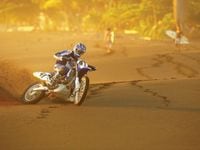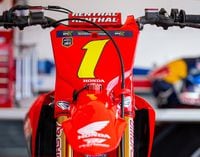The way we enthusiasts look at motorcycles is: Give it to me now! Manufacturers have a different approach that is mostly about the market-what the market is ready for and particularly if a bike is cost-effective. If true enthusiasts ran the business side of things, we'd have every new trick feature on our motorcycles as soon as it was possible to produce. But the bikes would cost a fortune, and the companies that built them would go broke. So be glad that Yamaha has held off the release of the new aluminum-framed WRs. The company was waiting for the right time.Now is the right time for a few reasons. First, the 2006-and-earlier steel-framed bike was due for a major upgrade. It has received the typical improvements over the last few years to keep it performing well and not falling off the pace in its class. But another year of updates might not have been enough. Timing comes into play as the WR's major competition, the Honda CRF-X and the KTM XC and XC-W, have undergone major redesigns in the last few years and seem to be resting on their laurels now. Second, there are plenty of Yamaha WR loyalists who may be sitting on a two-, six- or seven-year-old bike, just waiting for this one-they knew it was coming. Time's up, because the new WR is here.It's pretty much a clean-sheet WR, more like the '06 YZ450F than previous WRs. The aluminum frame is nearly the same as that of the motocross bike but differs in rigidity from the YZ in its specific combination of forgings, castings and extrusions. The engine is the new, simpler design with enclosed oil passages and the sump built into the engine, no longer storing oil high in the frame. Of course, there are also the changes made to accommodate the electric starting. Off-road goodies that didn't change include the 18-inch rear wheel, the wide-ratio five-speed transmission and the coolant-recovery tank and system. The lights, a 35-watt headlight and an LED taillight, get the job done if you are caught out after dark. The speedo/odo/trip/clock has enough functions to keep most riders-short of competition enduro riders-happy, and with new rule changes to enduros, this instrument is more than satisfactory. The aluminum kickstand, steel rear sprocket, O-ring chain and trapdoor air filter access all make the bike a lot more appealing than trying to convert an MX machine to work off-road. Then there is the setup of the suspension, which this year is targeted more for tight and technical types of riding.We rode the WR in a closed-course competition setting, unlike how it is sold off the floor at the Yamaha dealer. For more information on this setup, check out www.dirtrider.com, as you may be a little disappointed if you buy a WR and try to ride it box-stock. There are a few things, such as the throttle stop, the muffler insert and the secondary ignition curve, that keep the bike really choked up and, along with the sized-down airbox opening and complementary leaner jetting that amplify the effect, aim at passing the drive-by sound test and emissions requirements. Even an air-injection system is mounted on the side of the WR engine to burn off excessive emissions. The AIS system in particular is now being looked for by authorities where emission-compliant vehicles are mandatory (during the summer in California, don't ask!).The starter isn't the fastest spinning, but the bike fires right up. It then takes a bit longer to warm than a YZ. In Costa Rica (where the bike was unveiled before the media) every tank of gas was a new surprise-the quality was random, making it hard to truly feel how the bike was running-but these WRs proved they could and would run on low-octane fuel. They hiccuped and detonated, but they survived. We waited till we got a test bike back to California, where we could put some hard miles on it, to see what the new motor was really made of. Plainly put, it rips. It is much more lively than the old WR but at the same time still stays very smooth and progressive in the power buildup. The jetting we finally settled on is in the included chart. And if it is ever finicky, especially at idle or low throttle positions, just play with the fuel screw. The best thing about the bike is the big power that still comes with such a quiet exhaust note. With only the smallest muffler end-tip insert removed, the bike is whisper quiet and never has that snap-crack-burst of sound nor really roars decibels, even in the upper Rs. The bike is very quick and the power delivery is great for low-traction situations; it grabs traction when there is very little available. We have nothing but praise for this motor.The handling isn't as light and flickable feeling as the new WR250F. But when compared with last year's steel-framed bikes, the 450 definitely has a lighter feel that is most notable in side-to-side movements with the bike and again in the steering feel through the bar. It still has some girth to it, a good weight that helps the bike stay planted and makes it stick to the ground rather than deflect and dance over things, though some of its bite is from the power. It isn't heavy feeling by any means; it's definitely lost some hulk compared with the last couple of years of WR450Fs. You will notice this. Kiss top-heavy feel good-bye and good riddance!Suspensionwise, the Yamie has to find a balance between the plush and very linear suspension needed for Eastern conditions and the stiffness and holdup needed for faster conditions or sand riding. Yamaha went with a more-rigid setup compared with the softer-suspended WR250F so that the 450 will work in the faster stuff and carry its weight and speed. It still lets you feel the small bumps, like most lighter-weight, larger-displacement bikes or competition-focused 450cc four-strokes, especially at slower trail speeds. But if you pick up the pace and hit stuff aggressively, the bike feels a lot plusher and doesn't dance or deflect any longer. And it has great bottoming resistance at the end of the stroke without being too springy in the middle of the travel. For heavier riders, the initial bump feel isn't an issue at all, but riders lighter than 170 pounds will notice it. This bike (or any 450cc four-stroke) will never feel as light as a two-stroke in rocks and roots, but it will stick and absorb before it will kick or deflect.The bits and pieces are all first-rate, and we think Yamaha has found a great balance between what an off-road rider needs and the added weight that comes with that stuff. Bonus points for the long-wearing steel rear sprocket, the coolant-catch tank, the digital odometer and the lighting that really works. Nice ProTaper, too! The new airbox door makes the old one seem like a pain in the rear, and we can live with the dual oil drain plugs, even if all the oil comes from the same place. The gearing on the bike is adequate for most everything, and there's never a gap in the spacing: Top speed is in the high 80s, low 90s on dirt. The clutch stood up to plenty of abuse and isn't really needed to coax out power, just to calm it sometimes. Or it's sometimes needed for the really slow and nasty stuff, where the pull is just right. Quick-adjust, too, if you really get it hot! (Remember to readjust after it cools.) The Yamaha brakes give all you ask of them and, along with the O-ring chain and wheel spacers and bearings, have stood up to mud in the past like they are supposed to. The tank runs a little small for our tastes-getting 60 miles out of a tank on a trail ride or more than 45 in racing conditions is asking a lot-but it is narrow!What do we really think of the new WR450F? Well, we love it! It begs the question, Which is the new king of the 450cc off-road wars? With Kawasaki coming into the game really soon, we're bound to find out in some sort of a shootout as soon as we gather all the bikes together. But if you bleed blue and have been trying to liven up your steel-framed bike without much success, this is the immediate answer.What's Hot
The all-new WR you've been waiting for.Lighter feeling, better power, cleaner package.
All the off-road stuff a bike really needs.Yamaha four-stroke motor durability.You could ride it like the dealer sells it, corked up, which is better than in the past, but you won't want to for long.What's Not
The effort required (and money) to uncork the standard package to get to the closed-course competition setting (GYT-5TJ93-69-01, $49.95).
Getting to the carb is a hose-and-wire-filled nightmare.You buy your own hand guards!Opinions
My first ride on the WR was in Costa Rica and was largely on a Jeep road with washboards and very little technical riding. I begged the tour guides for more nasty stuff, but between having the Yamaha PR guy telling them not to kill off any journalists and the tour company's fear of journalists wrecking what were to soon be its fleet of almost-brand-new Yamaha WRs, I was restricted to only average riding terrain, not what we'd typically consider material for a test back home. The trip was fun, especially the beach-I still shake thinking about it. So we got a bike here and went to work. And every time I ride this bike I like it more. It feels lighter every time I ride it. The power grows on me; it's very similar to the YZ with each ride but tuned for its trail-gobbling nature. And it is so quiet, I think the loudest thing is the chain slapping on the buffer pad. If you are asking me what I think of this bike and if you really should buy this bike, my answer is, "Yes!"-Jimmy Lewis/5'10"/185 lb/A-riderLately, most of my riding time has been aboard the '07 YZ450F, and I love the bike for moto and even like it off-road. Knowing the similarities in the basic platform, I was more than anxious to get miles on the '07 WR450F. The WR hides its added weight (compared with the YZ) very well, and the electric start and radiator catch-tank system are well worth the weight. And I love a kickstand. The seat is a little softer than the YZ, but otherwise the chassis feels similar. If anything, the WR has more bark at low rpm than the super-smooth YZ does. The gearbox spacing is very nice for trail work as well. For any sort of special-test-type section with a little flow to it, the WR rules the roost. It cranks through turns and has controlled suspension. Right/left transitions are quick and easy. But on a survival-type trail ride, I got stuck in ruts that my buddies motored right through on their KTM four-strokes. A quick check with a tape measure after the event showed the WR is 1.5 inches wider at the footpeg mounts and has 1.5 inches less ground clearance. Nevertheless, I truly enjoy the bike off-road and can't wait to get more time in the saddle.-Karel Kramer/6'1"/210 lb/B enduro riderMSRP: $7199
Claimed dry weight: 247 lb
Actual weight (ready to ride, no fuel): 259 lb
Seat height: 34.6 in.
Seat-to-footpeg distance: 19.6 in.
Ground clearance: 10.5 in.
Latest

/cloudfront-us-east-1.images.arcpublishing.com/octane/W2WMWDRFVJD6HP4XCRFISKUVLI.jpg)
/cloudfront-us-east-1.images.arcpublishing.com/octane/FUUS4XCVVZHYLBVJDLUGRT7RZQ.jpg)
/cloudfront-us-east-1.images.arcpublishing.com/octane/FSUTQ6NZ7RCO3M4NCBRJPKNM5M.jpg)
/cloudfront-us-east-1.images.arcpublishing.com/octane/XAZ2DGYTEJA2BE2TQ6H3KWXW4U.jpg)
/cloudfront-us-east-1.images.arcpublishing.com/octane/WC2HVBKSHNEJBODES2R5Y53VRY.jpg)
/cloudfront-us-east-1.images.arcpublishing.com/octane/JRSZS66MQBDH7O2JNMJHBQKIA4.jpg)
/cloudfront-us-east-1.images.arcpublishing.com/octane/WM3CKNM255E7NLISG3J5SOU63Y.jpg)
/cloudfront-us-east-1.images.arcpublishing.com/octane/XP5WDDR2AVGR3BF5S6TPCGYJ5A.jpg)
/cloudfront-us-east-1.images.arcpublishing.com/octane/7UAIG5GYLZH7LD72MKUYIHQYWU.jpg)
/cloudfront-us-east-1.images.arcpublishing.com/octane/6KXNSCIBK5BUNIJXUUELRO5W5Q.jpg)
/cloudfront-us-east-1.images.arcpublishing.com/octane/ZEQ7DSS7ZJCSLDAPECTSOAOGXI.jpg)
/cloudfront-us-east-1.images.arcpublishing.com/octane/OFSXJJ5PZFEZ5D5ZPMCFVHJUMA.jpg)
/cloudfront-us-east-1.images.arcpublishing.com/octane/N2JLNLG44VEKBMEPORRDTMX5A4.jpg)
/cloudfront-us-east-1.images.arcpublishing.com/octane/EOERU244ONEWVKQ7C24OHMRVWY.jpg)
/cloudfront-us-east-1.images.arcpublishing.com/octane/JF4T3ULTGNHTVEKSTNKLJ2IGKY.jpg)

/cloudfront-us-east-1.images.arcpublishing.com/octane/FAOZEEEXFVA3ZK2PYMY3DHI2EQ.jpg)
/cloudfront-us-east-1.images.arcpublishing.com/octane/WCAUGYKA5FDZTB64FM36LJFMMM.jpg)
/cloudfront-us-east-1.images.arcpublishing.com/octane/EIDVOIN5IJDMRIVS2VNTOOBVSA.jpg)
/cloudfront-us-east-1.images.arcpublishing.com/octane/5BSWCTPONFB3DJFRPJ34STZMR4.jpg)
/cloudfront-us-east-1.images.arcpublishing.com/octane/KSERUHQUTNHLBCWKXS2R3TYZHI.jpg)
/cloudfront-us-east-1.images.arcpublishing.com/octane/GGOH2AQRSVHY5C5JLNEVYLB5SU.jpg)
/cloudfront-us-east-1.images.arcpublishing.com/octane/TJJEHV3ATZFFXHUYZABHXKE2DI.jpg)
/cloudfront-us-east-1.images.arcpublishing.com/octane/M7L5LNQ5JZENHNBTCHEIKZKD24.jpg)